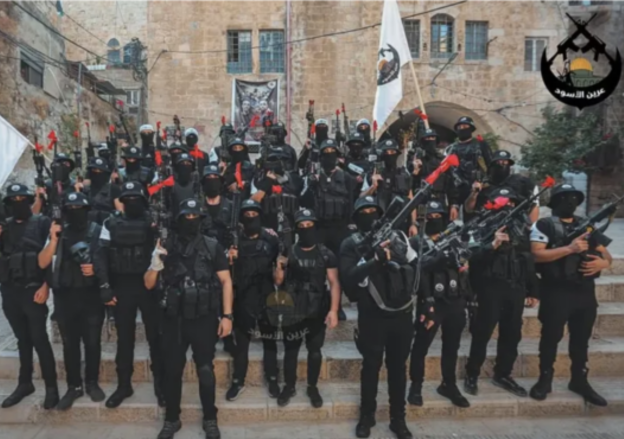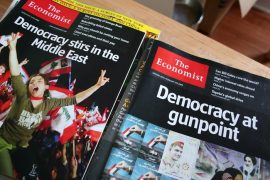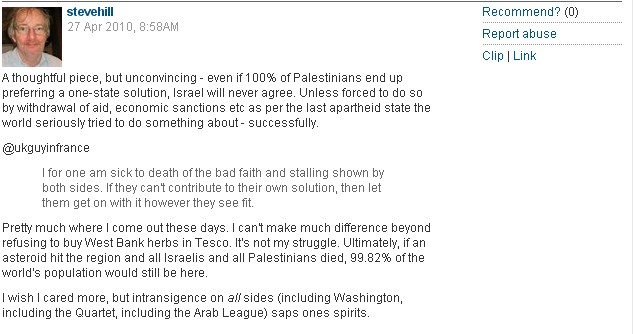Written by CAMERA’s Karen Bekker
In much of the reporting about Israel and the Middle East, terrorist organisations are entirely absent. In a recent article in the Economist, however, terror groups are the focus – but the effects of terrorism are glossed over, and the members are glamorised as if they were social media influencers. “Inside the Lions’ Den: the West Bank’s Gen Z fighters,” reads the headline, strangely applying a US marketing term, “Gen Z,” to terrorists halfway around the world. (July 7, 2023, by Ayman Oghanna.)
Consider, for example, this bizarre description of the Second Intifada:
When al-Ajoud was 14, in 2002, he and a friend were hit by a shell from an Israeli tank. Al-Ajoud survived but his friend was killed instantly. It was a formative event: “Every fighter was inspired by the second intifada (uprising).” At the time, Nablus was a centre of opposition. Armed and unarmed Palestinians jousted with the Israeli army’s tanks, armoured personnel carriers and Apache helicopters. The Israelis imposed strict curfews and house-to-house searches. Thousands of Palestinians were arrested and many homes were destroyed.
The peace that followed was an unhappy one. Memories of Israeli violence lingered….
There’s no mention of the reason for Israel’s actions – the many suicide bombings that caused so much devastation to Israeli civilians as well as to Americans such as Malki Roth and her family. Over 1,000 Israelis were killed, including teenagers in pizza shops and nightclubs. Nor does reporter Ayman Oghanna mention the fact that Palestinian Authority President Yasser Arafat started the Second Intifada intentionally, after rejecting the Camp David offer of an independent Palestinian state that would have included sovereignty over Judaism’s holiest site. On the 20th anniversary of the Second Intifada, the Jerusalem Post’s Herb Keinon wrote, “this harrowing period fundamentally altered Israeli society….” But the effect on Israeli society is completely absent from this account, which makes Palestinians the heroes, rather than the perpetrators, of the “inspir[ing]” Second Intifada.
Considering that the ostensible goal of the article is to inform readers about terror organisations, however, it’s curious that a certain amount of obfuscation of who they actually are persists. “In the past two years violence has escalated,” the Economist’s readers learn. Who escalated it? That’s not an important enough detail to include. In the IDF operation in Jenin that began on July 3, “twelve Palestinians were killed and dozens were wounded and captured,” Oghanna tells us, omitting that at least ten, if not all 12, of those killed were affiliated with such groups – and of those, eight were from Islamic Jihad. His use of the term “captured,” rather than “apprehended” or “arrested,” implies an illegitimacy to that action.
And, he tells us, “in the first half of this year 114 Palestinians and 16 Israelis were killed in the West Bank (in the same period last year, 57 Palestinians and two Israelis were killed).” Of course, as CAMERA has noted repeatedly, of the Palestinians killed, more than half were committing attacks or affiliated with terrorist groups. This second statistic is also an example of the false equivalence we’ve seen so often in the media: Of the twenty Israelis and tourists to Israel killed in attacks this year, all but one were civilians – including several children, such as Asher and Yaakov Paley, aged 8 and 6, brothers who were killed in February.
But the real goal of the article, like a similar piece in the New York Times this week, is to valorise terrorism. Oghanna describes the Lions’ Den as a “Palestinian armed-resistance group based in the Israeli-occupied West Bank” (despite the fact that the Lion’s Den’s base is in Area A) and as “the face of Gen Z Palestinian resistance.” As CAMERA’s Gilead Ini pointed out, referring to terror groups as “resistance” – which the Economist does four times in this one article – makes them seem “understandable, acceptable, or as the word’s noble lineage suggests, even desirable.” The opening passage, in which Oghanna tries to impress his readers with his seemingly daring passage to a Lion’s Den safe house, seems to try to imitate the opening of a spy thriller.
Also noteworthy is the following passage comparing three different deaths:
One café in the Old Town is named after Abd Subah, a Lions’ Den member who was killed by the Israelis. On its sign is the warning: “May God curse anyone who betrays us.” A video posted on social media recently shows the terrified, exhausted confession of a 23-year-old fighter called Zuhair al-Ghaleeth. Exhaling deeply, he states that Israeli agents used a video of him having sex with another man as blackmail, forcing him to gather intelligence on the Lions’ Den leaders. Soon after his confession, Ghaleeth was gunned down on the street in Nablus and died in hospital.”
Ghaleeth was not given a martyr’s funeral. Saleh Sabra was. In May the 22-year-old fighter was shot dead by Israeli forces during a raid in Nablus as people prepared to mark the 75th anniversary of the Nakba (“catastrophe”): what Arabs call the displacement of 700,000 Palestinians during the establishment of the state of Israel in 1948. In the days before the raid, the Israeli army had bombed the Gaza Strip, killing 33 Palestinians and leaving hundreds homeless. Two Israelis were killed by Palestinian rockets.
Who gunned down Ghaleeth? Oghanna doesn’t tell us, and it seems odd that no editors caught this, or the confusingly written passage that seems designed to obscure it. So readers are left to speculate – but those familiar with the culture of militant organisations will have a good guess.
The complete absence of any Israeli or Jewish perspective is apparent throughout. It’s reflected in the fact that Oghanna refers to Nablus as “a Palestinian city in the West Bank.” In fact, Nablus, also known as Shechem, predates the advent of Islam by thousands of years, and is the site of a tomb where Biblical Joseph is said to be buried. Last year Palestinian rioters set this holy site on fire. It’s also evident in Oghanna’s definition of “the Nakba (‘catastrophe’)”: “what Arabs call the displacement of 700,000 Palestinians during the establishment of the state of Israel in 1948.” The five invading Arab armies that caused Palestinians to flee…well they don’t warrant a mention.
At the same time, however, there’s a lot to be gleaned from this article about the attitude towards Lion’s Den and similar groups in Palestinian West Bank society. We learn from Oghanna that “polls of Palestinians show strong support for armed groups.”
In Nablus, souvenir shops sell Lions’ Den mugs, necklaces, trinkets and flags emblazoned with the group’s logo – Nablus’s An-Nasr mosque, garlanded by two assault rifles and an Islamic crescent – and the faces of slain fighters. Memorabilia like this is generally associated with more established militant groups; that it exists already is a sign of how quickly the Lions’ Den has penetrated the public consciousness. In the old town, posters of young men are plastered over doors, shop windows, arches and road signs. If you listen carefully, you can hear songs praying for the souls of martyrs….
Additionally, we learn, “the founders of Lions’ Den wanted to create a group that united disaffected fighters who felt the current armed movement was too weak.” And that Rabab al-Azizi, the mother of a slain Lions’ Den fighter, “took comfort in the solidarity of the community: ‘I’m proud that my son is an icon for the neighbourhood,’ she said. ‘On Mother’s Day the locals even baked me a cake with Muhammad’s face on it.’”
Certainly, it’s newsworthy that Palestinian society views terrorists this way. The problem in this article, though, is that it seems as if the reporter shares this view. Everything about the article, from the photo at the top of a poster of a smiling man with a gun (which Oghanna took as well), to the description of the “chants of hundreds of young men” at a funeral: “‘Oh martyr how lucky you are; I wish my mother was in your shoes!’” seems designed to glorify and idealize these terrorists. This isn’t journalism, it’s hagiography.
Related Posts
Times’ reporter tries to turn Palestinian terrorist into a civilian





